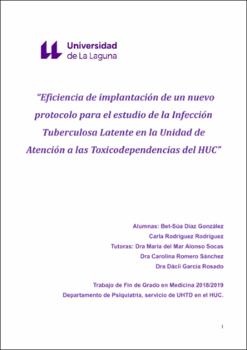Eficiencia de implantación de un nuevo protocolo para el estudio de la infección tuberculosa latente en la Unidad de Atención a las Toxicodependencias del HUC.
Fecha
2019Resumen
La identificación de la infección tuberculosa latente (ITL) es relevante en determinados colectivos
sociales como los usuarios de drogas. Realizamos este estudio para analizar la prevalencia de ITL en
los pacientes que ingresan en la Unidad Hospitalaria de atención a las Tóxicodependencias (UHTD)
del HUC y evaluar la rentabilidad de la implantación de un organigrama para la detección de la ITL
en la UHTD.
Material y métodos: Se analizaron todos los pacientes que ingresaron en la UHTD durante un año
(1/5/18 al 30/4/19), dividido en dos periodos: previo a la implantación del organigrama el 1/11/18 y
posterior a la implantación del mismo.
Resultados: Se analizaron 326 pacientes con una mediana de edad de 44 años. La causa más frecuente
de ingreso en la UHTD fue el consumo de alcohol (58%) seguido del de cocaína base. El 20% han
consumido drogas vía parenteral. El 23,9% de los pacientes tenían Mantoux positivo. El porcentaje
de la realización del Mantoux fue menor en el segundo periodo tras implantación del Organigrama.
Se comprobó conversión tuberculínica en 17 pacientes (18,8%), sin TBC activa. Tras la implantación
del organigrama se ha reducido el coste en el despistaje apropiado de la ITL.
Conclusiones: La UHTD permite detectar ITL y TBC en población de alto riesgo. La normalización
de la práctica clínica permite ser más eficientes en la actividad asistencial. The identification of the latent tuberous infection (ITL) is relevant in some social groups as drug
users. We did this study to analyze the continuation of the ITL in patients that are hospitalized in the
Toxicodependency attention area of HUC and evaluate the profitability of implanting an organigram
to prevent the ITL in the Toxicodependency attention area.
Material and methods: All patients hospitalized in the Toxicodependency attention area were analyzed
during one year (from 1/5/18 to 30/4/19), divided into two periods, before the implementation of the
organigram the 1/11/18 and after it.
Results: 36 patients of 44 years old (average) were analyzed. The most common cause of
hospitalization in the Toxicodependency attention area was alcohol, and cocaine. 20% of them have
consumed drugs by injection. 23,9% of them had positive Mantoux. The percentage of the Mantoux
test was less in the second period, after having implanted the organigram.
Tuberous conversion was confirmed in 17 patients (18'8%) without active TBC. After the
implementation of the organigram the cost of the early diagnosis of ITL decreased.
Conclusions: the Toxicodependency attention area can detect ITL and TBC in people with high risk
of having it. The normalization of the clinic practice allows us to be more eficient in the assistance
activity.





